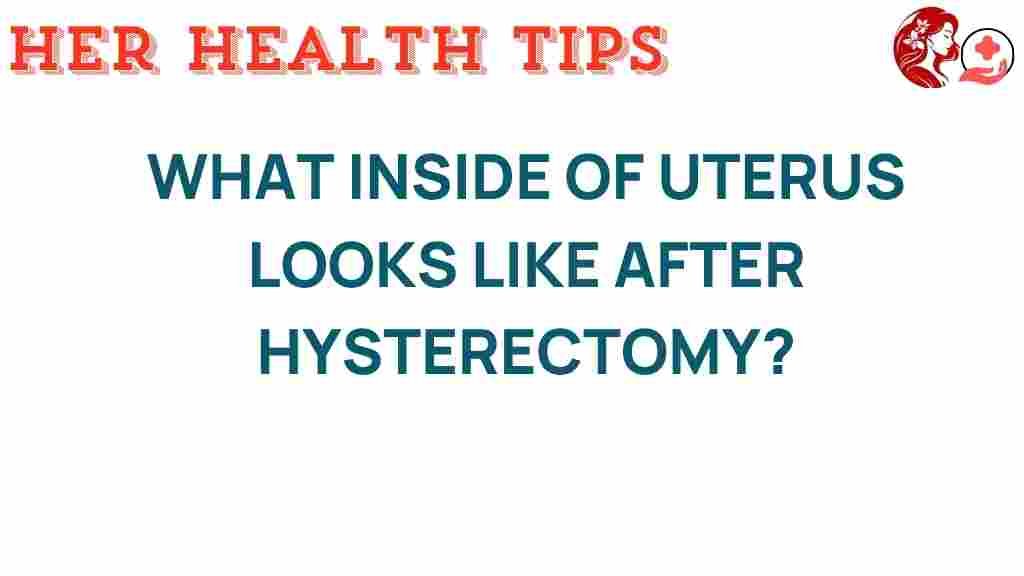Understanding Hysterectomy: The Post-Surgery Uterus
Hysterectomy is a common surgical procedure that involves the removal of the uterus. This operation may be necessary for various medical reasons, including uterine fibroids, endometriosis, or cancer. However, many women are left wondering about the state of their uterus post-surgery and how it affects their overall health and wellness. In this article, we will unveil the post-hysterectomy uterus, discussing what lies beneath the surface, the recovery process, and the long-term implications for female anatomy and reproductive health.
The Anatomy of the Uterus Before and After Hysterectomy
The uterus is a vital organ in the female reproductive system, playing a crucial role in menstruation, pregnancy, and childbirth. Understanding its structure is essential for recognizing the changes that occur after a hysterectomy.
What Happens During a Hysterectomy?
A hysterectomy can be performed in several ways, including:
- Abdominal Hysterectomy: The uterus is removed through an incision in the abdomen.
- Vaginal Hysterectomy: The uterus is removed through the vagina without the need for abdominal incisions.
- Laparoscopic Hysterectomy: This minimally invasive technique uses small incisions and a camera to guide the surgery.
During the procedure, the surgeon may remove additional structures such as the cervix, ovaries, and fallopian tubes, depending on the medical necessity. Post-surgery, the absence of the uterus can lead to significant changes in a woman’s body and health.
The Post-Surgery Uterus: What Lies Beneath?
Once the uterus is removed, there are several immediate and long-term changes that occur in the body:
- Absence of Menstruation: Women will no longer experience menstrual cycles, leading to changes in hormone levels.
- Hormonal Changes: If the ovaries are removed during the hysterectomy, women may enter menopause immediately, leading to symptoms such as hot flashes and mood swings.
- Changes in Pelvic Anatomy: The removal of the uterus alters the pelvic floor dynamics, which may affect bladder and bowel function.
Recovery After Hysterectomy
Recovery from a hysterectomy varies depending on the type of surgery performed, the individual’s health, and adherence to post-operative care.
Initial Recovery Phase
The initial recovery phase typically lasts from 6 to 8 weeks. During this time, women should focus on:
- Resting and avoiding strenuous activities.
- Monitoring for any signs of infection, such as fever or unusual discharge.
- Following the surgeon’s guidelines for pain management and wound care.
It is crucial to attend follow-up appointments to ensure proper healing. During these visits, healthcare professionals will assess the surgical site and address any concerns that may arise.
Long-Term Recovery and Wellness
As the body heals, women should prioritize their overall wellness to support recovery:
- Nutrition: A balanced diet rich in vitamins and minerals can aid recovery. Focus on:
- Fruits and vegetables
- Whole grains
- Lean proteins
- Exercise: Gentle activities, such as walking, can improve circulation and promote healing. Gradually increase intensity as directed by a healthcare provider.
- Mental Health: Emotional adjustments may be necessary post-surgery. Consider counseling or support groups if needed.
Health Implications of Hysterectomy
Understanding the health implications of a hysterectomy is essential for women considering this procedure.
Impact on Reproductive Health
With the uterus removed, women will no longer have the ability to conceive. This can be a significant emotional consideration and should be discussed with a healthcare provider before surgery.
Potential Risks and Complications
Like any surgery, a hysterectomy carries potential risks, including:
- Infection
- Bleeding
- Blood clots
- Damage to surrounding organs
It’s vital to weigh these risks against the benefits when considering a hysterectomy for reproductive health issues.
Troubleshooting Post-Surgery Concerns
After a hysterectomy, some women may experience unexpected symptoms or challenges. Here are some common issues and suggestions for dealing with them:
1. Emotional Changes
Many women report feelings of sadness or loss after surgery. This is normal, but if these feelings persist, it may be helpful to:
- Seek counseling or therapy
- Join support groups for women who have undergone similar experiences
2. Physical Discomfort
Post-operative pain is expected, but if pain worsens or is accompanied by other symptoms, consult a healthcare provider. Strategies for managing discomfort include:
- Following prescribed pain medication schedules
- Using heat packs for abdominal pain relief
3. Changes in Sexual Function
Women may notice changes in libido or discomfort during intercourse after surgery. Open communication with your partner and consulting a healthcare provider can help address these concerns.
Conclusion: Embracing a New Chapter in Health and Wellness
In conclusion, a hysterectomy can be a life-altering procedure that impacts a woman’s health and wellness. Understanding the anatomy of the uterus, the recovery process, and the potential implications on reproductive health is crucial for those considering or recovering from this surgery. By prioritizing recovery, addressing emotional and physical changes, and seeking support when needed, women can embrace this new chapter in their lives with confidence.
For more information on female reproductive health, consider visiting this resource. If you’re looking for support or community after your hysterectomy, check out our wellness programs designed specifically for women navigating post-surgery challenges.
This article is in the category Reproductive and created by HerHealthTips Team
